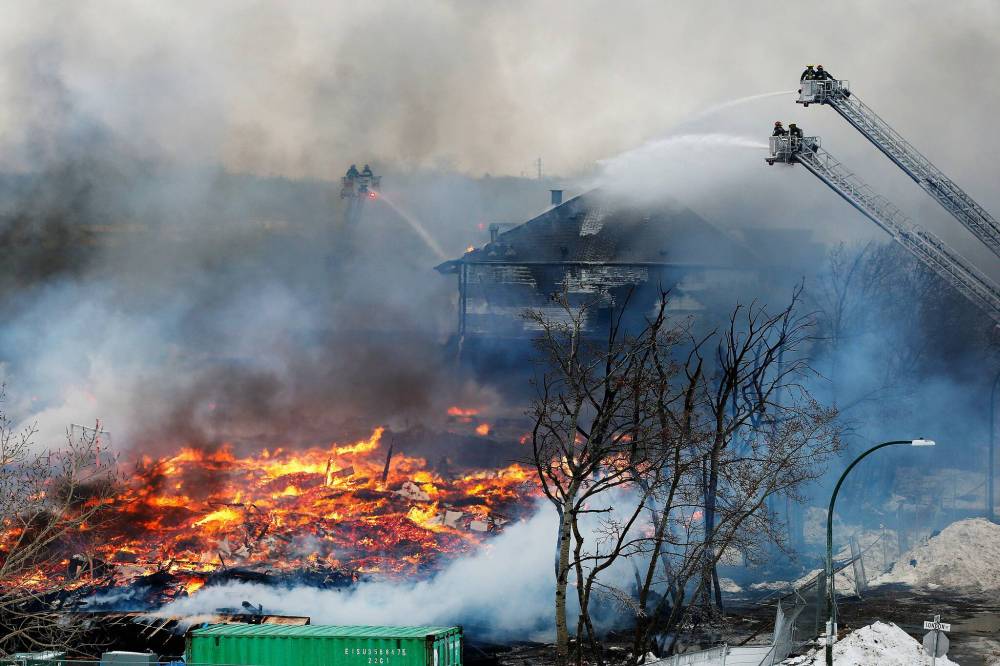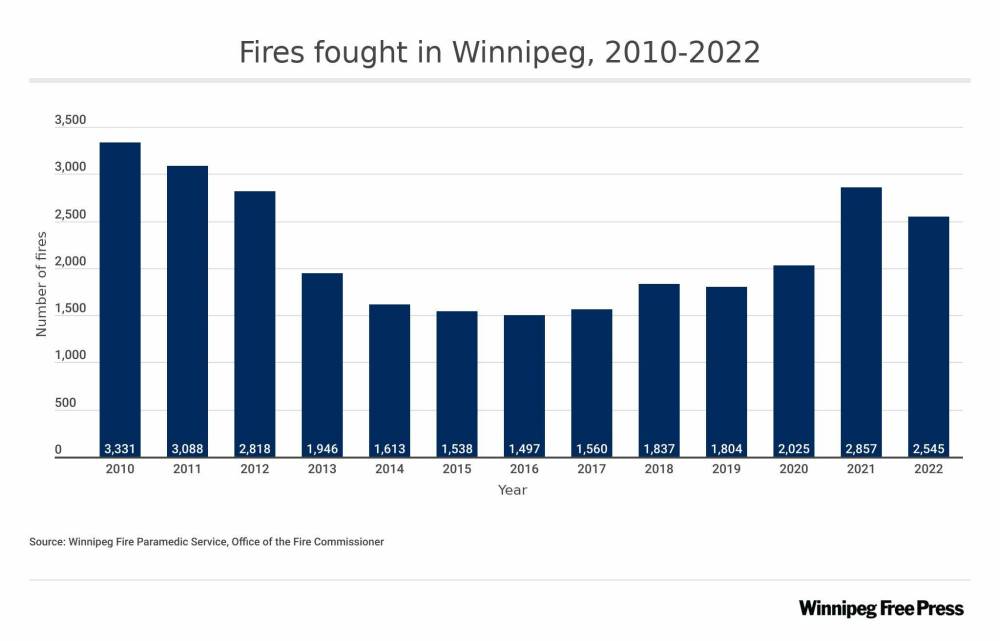Crews running ‘all day, every day’
Fire calls down in 2022 but workload remains high
Advertisement
Read this article for free:
or
Already have an account? Log in here »
To continue reading, please subscribe:
Monthly Digital Subscription
$19 $0 for the first 4 weeks*
- Enjoy unlimited reading on winnipegfreepress.com
- Read the E-Edition, our digital replica newspaper
- Access News Break, our award-winning app
- Play interactive puzzles
*No charge for 4 weeks then billed as $19 every four weeks (new subscribers and qualified returning subscribers only). Cancel anytime.
Read unlimited articles for free today:
or
Already have an account? Log in here »
Hey there, time traveller!
This article was published 21/03/2023 (395 days ago), so information in it may no longer be current.
Winnipeg firefighters were summoned to fewer calls in 2022, but they were still run off their feet as sick days and overtime surged.
“To be frank, it’s quite onerous. Our crews run very, very busy days,” said Winnipeg Fire Paramedic Service Assistant Chief Scott Wilkinson.
“We also have large numbers of medical calls, so between the medical calls and fire calls, our crews are running all day, every day.”

In 2022, there were 2,545 fire calls, down from 2,857 in 2021.
The slight decrease — 312 fires — can be credited to a wetter-than-normal summer in 2022 and the efforts of risk-reduction outreach teams, including a fire prevention officer who talks to people who live in camps about fire safety in an effort to prevent fatalities.
While the number of fires dropped last year, the workload was still heavy, especially because staffing took a hit.
The Free Press has reported sick days and overtime soared last year for both fire crews and paramedics.
In the first five months of 2022, the number of sick days jumped to 16,695, including long-term leaves and denied workers compensation claims, from 10,535 in all of 2021. Overtime hit 154,126 hours from Jan. 1 to May 31, 2022, from 110,023 in all of 2022.
The assistant chief said population growth and having an older housing stock are two factors behind the high number of calls.
Poor wiring and a lack of fire alarms increase the risk in old buildings.
“We do have a lot of higher incidences of vulnerable populations living in those older homes, who may not be using the best fire safety or education… When people are focused on issues of survival and putting food on the table, paying rent and trying to get through, sometimes these other issues such as fire safety considerations fall by the wayside,” he said.
Exacerbated by the pandemic, poverty, addiction and mental health issues have boosted the number of people living in tents and vacant buildings, which is part of the equation. But fire service numbers show outdoor fires, including wild fires and in encampments, decreased by about 500 in 2022, to just over 1,500.

JOHN WOODS / WINNIPEG FREE PRESS FILES
In 2022, there were 2,545 fire calls, down from 2,857 in 2021.
Firefighters have responded to an increasing number of calls annually: in 2020, there were 2,025 calls; in 2019, 1,804 incidents; and in 2018, there were 1,837 calls.
WFPS spokeswoman Erin Madden said Winnipeg has a higher fire rate than other cities in Canada, and its poverty rate is an aggravating factor.
Winnipeg had 1.53 residential fires with losses per 1,000 households in 2018, compared to 0.83 in Montreal, 0.76 in Toronto, 0.67 in Hamilton and 0.61 in Calgary, Madden said, citing a 2021 city budget community trends report.
Wilkinson said myriad issues affect fire statistics, including mental health issues, substance abuse and housing affordability.
Fires in vacant buildings have increased year-over-year since 2015, the data show, from just nine that year to 84 in 2022.
The service, along with city police and the bylaw department, have been working together to reduce safety risks by ensuring that vacant structures are inspected and boarded up.
Madden added that a fire prevention officer has made a difference in terms of reducing potential risk in encampments.
“He works with residents to ensure their safety, providing education on fire prevention and carbon-monoxide risks and helping to connect them to resources. We strongly believe the relationships he’s built, both with residents and our partner agencies have helped to save lives and prevent fires and other tragic events,” she said.
Wilkinson said the service does fire safety messaging, including working with community groups and sending staff to speak to people where they live, to try to prevent fires.

“We have programs like our community fire prevention partnership which has both the community and our fire crews monitoring for some of these hazards… that could lead to opportunistic arson, and reporting them to have them addressed,” Wilkinson said, as an example.
Unsafe smoking, cooking and improperly maintained appliances such as space heaters, are other nagging issues, not to mention keeping smoke detectors functioning.
“If everyone has the proper amount of properly located smoke alarms in their residence, they should be able to get out of that home safely,” he said.
“So we have a fire, we may lose property, but we won’t lose lives.”
erik.pindera@freepress.mb.ca
Twitter: @erik_pindera

Erik Pindera
Reporter
Erik Pindera reports for the city desk, with a particular focus on crime and justice.



